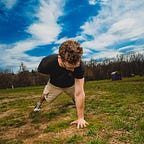“Move Younger” While Increasing Your Strength & Fitness
I’ve always been a big believer in flexibility training. Notice I didn’t just say “random stretching” but actual focused flexibility work that helps you expand your available ranges of motion and helps you move like a kid again — with ease, grace, resilience, and confidence to move in your own skin. In other words, stretching as it should be.
Everyone seems to find value in stretching, but all too frequently people don’t put much thought into it; it’s treated either as a warm-up or a cool-down just to hedge your bets against getting hurt during your workout or feeling ‘stuck’ in your own body afterward as your muscles seize up from DOMS (Delayed Onset Muscle Soreness) a day or two after.
And I totally get it: stretching isn’t all that sexy and it doesn’t burn a pile of calories, but it doesn’t have to, and it’s not supposed to. Stretching is your support for the moves that *do* burn piles of calories and let you do sexy stuff (I’m talking about sexy exercise stuff, just for the record).
The old timers (i.e. old time strongmen) knew this instinctively, and as such they focused every bit as heavily on their recovery as they did on their lifting, and many of them had ballerina-type flexibility to go along with their gorilla-level strength.
Case in point:
British berserker Bert Assirati was known to lower himself into a full back bridge from standing and then kick up into a one-arm handstand. Not bad for a guy who weighed 120 kilos (240 lbs) and squatted over 800 lbs before heavy squatting even came in vogue.
Eugen Sandow — the Father of Modern Bodybuilding — summed it up perfectly when he said the following:
“”The radical mistake is also made of over-training, and of developing the muscles till they feel like iron, forgetting that flexibility rather than hardness is the symbol and condition of health.”
So how can you start improving your own flexibility and reclaiming the graceful, resilient, confident, and stiffness-free movement of your youth while simultaneously increasing your strength and conditioning? There are a few ways, and here is what I would recommend:
- Treat your flexibility like strength training. Focus on tension and relaxation as you would in a workout, and focus on technique; don’t be sloppy. Likewise, think in terms of sets and reps, and put all your focus into what you’re doing; no scrolling Facebook or checking your email while you stretch! Unless you’re reading one of my emails, in which case you have my blessing.
- Set aside a few days a week to work on it. Your off days from training would be a perfect example, and much of your flexibility work can be done relatively quickly and simply. While you most certainly can throw them in before and after a training session, I’ve found quite often that when you find yourself with less training time than you had originally thought, you end up skipping one thing or another, and that’s usually stretching. So plan some separate time for it and get it done come hell or high water.
- Focus on stretching movement patterns. Individual stretches for each little innie and outtie muscle have their place, but you wanna focus on stretches that affect entire movement patterns and regions of the body to hit a boatload of muscles all in one shot. There is definitely a time and a place for stretching and zeroing in on smaller muscles, but if you’re tight on time (pun intended), you don’t want to make that your sole focus. Keep your eyes on the bigger picture.
The list could go on, but you get the picture.
These principles will get you started off on the right foot and make sure you’re moving forward meaningfully toward better movement, less discomfort in every nook and cranny of your body, and will help keep your fitness results coming for a long time.
As they say, the devil is in the details, so in order to make the most of these instructions here’s a sample of the choicest flexibility drills that I know you’ll find awesome and immediately useful.
Called The Trifecta, I first heard about this routine in Convict Conditioning 2, and was instantly hooked.
Check out this brief video on the topic and have at it
Another great (and underrated) way to get your body moving and performing better than ever is by training actual factual human movements — particularly those that encompass the Gait Pattern.
The Gait Pattern is your walking pattern, and is arguably the most unique and crucial of all human movement patterns. Strengthen this and it can open up a world of new strength, stamina, coordination, leanness, resilience, and more.
If that’s your jam, you just might like my 9-Minute Kettlebell & Bodyweight Challenge.
It consists of some simple, easy-to-learn movements that I can almost guarantee you’ve NEVER done (including crawling, loaded carries, etc) and as the name implies, it only takes 9 minutes to do.
Not only does it fit neatly at the end of whatever other routine you’re currently doing anyway (so no need to put your regular training on hold), but many people have found that it actually enhances their workouts.
Have a look-see at what a gent named Deo had to say when he added my 9-Minute Kettlebell & Bodyweight Challenge into his current kettlebell program:
==
“Simple on paper but surprisingly challenging in an unusually pleasant way. With a focus on the gait pattern, I can tell I’m working things in my body that aren’t being directly challenged otherwise, strengthening foundational elements. I finish feeling refreshed and not beat down, but still knowing I did quality work for my body.”
==
Check it out for yourself at www.9MinuteChallenge.com
Have fun and happy training!
Aleks “The Hebrew Hammer” Salkin
